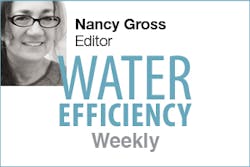I sometimes drink tap water, though my preference is to fill a jug from a windmill-driven local well. The property owner has the water for sale at a hose end beside the road and asks people to put a quarter into a box for every gallon. He also sells native plants in his vending area, again by the honor system. In fact, the place is a native plant farm.
There are wooden shelves, and a cement and stone structure for the water outlet. A sign invites visitors to have one free drink from a water fountain at the top, or to refresh their pet at a dog dish by the lower spigot. The whole setup is not far from a hiking area, and is easy for me to access when I make the rounds of several small fruit and vegetable stands.
Because I’ve gotten better at maintaining my routine, making the rounds, and filling my jug, I hadn’t tasted our tap water for a little while. When I drank some over the weekend I fully understood the protests some of my neighbors have been making to the water company. There is an extra-strong earthy flavor. Grassy. I checked the news to see how our reservoir lake is doing.
It is, as many in California are, at a historic low. Additionally, there is an algae bloom. In our case, it is not associated with agricultural runoff, but is rather the result of the low water level and higher than usual summer temperatures. We are told that we are not in danger. The alga (a plural form I only just learned of from my spell check) has not reached a toxic level and it is being treated with hydrogen peroxide and copper sulfate.
Not all algae blooms are harmful to humans or other animals – NOAA says only 1 percent are: http://oceanservice.noaa.gov/facts/habharm.html. Some can nonetheless harm the environment by blocking sunlight or depleting oxygen even if they are not producing toxins.
In our first issue of WE this year we ran Dan Rafter’s “An Unwanted Bloom – Algae” which comments on the toxic bloom experienced by Toledo, Ohio last summer, and discusses treatment methods that may help municipalities struggling with the nitrate and phosphorus runoff that is known to incite the blooms.
Predictions for Toledo this year were varied, but after last year’s incident that left 400,000 customers without tap water for three days, Toledo has set up an early warning monitoring system for microcystis.
Here is a link to an announcement from EPA in May, “EPA Issues Health Advisories to Protect Americans from Algal Toxins in Drinking Water.”
And here is an article that ran in Stormwater, our sister publication, that talks about an every-five-year sampling practice at Lake Erie that looks at numerous factors, including those related to algae blooms: “Doctoring Lake Erie.”
